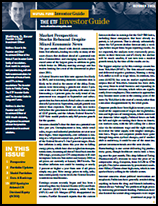The Investor Guide to Vanguard Funds for April is AVAILABLE NOW! Links to the April data files are posted below. Market Perspective: Inflation Hampers Rate Cut Possibilities Accelerating inflation kept […]


The Investor Guide to Vanguard Funds for April is AVAILABLE NOW! Links to the April data files are posted below. Market Perspective: Inflation Hampers Rate Cut Possibilities Accelerating inflation kept […]

The Investor Guide to Fidelity Funds for April 2024 is AVAILABLE NOW! April Data Files Are Posted Below Market Perspective: Commodities Surge Stifling Rate Cut Expectations Small-cap stocks extended their outperformance […]


Links to the September Data Files have been posted below.
Market Perspective: Bonds Rewarding Conservative Investors
The largest technology stocks helped float the Nasdaq to an increase of 0.57 percent last month, while worries about the banking system amid rising rates helped sink the Russell 2000 Index 2.57 percent. The 10-year Treasury yield was poised for a major bullish breakout or an important double top heading into September, but it’s left trades in limbo by chopping sideways. At the same time, energy and inflation-related ETFs have surged in momentum, with some energy sector indexes climbing to new all-time highs. The market is contemplating whether inflation is really finished, with crude oil up nearly 40 percent since June, but the market is still being led by tech stocks. Economic growth looks solid for the quarter, with all three Federal Reserve banks that have forecasting models boosting their estimates.
If the top-10 Nasdaq stocks were their own index, they would already be at a new all-time high this year. Meanwhile, the Russell 2000 Index is still 25 percent below its 2021 high and only about 8 percent above its 2022 low. The difference comes mainly from a combination of three factors. First, investors historically view smaller-cap stocks as riskier and therefore sell them during periods of higher volatility. Second, many investors are funneling cash on autopilot, most of it into passive market-capitalization-weighted funds such as the S&P 500 Index. Third, the largest stocks are currently in the technology sector, helping boost indexes with hefty tech exposure such as the Nasdaq.
At some point, investors will buy bonds because the yields will be too enticing, but that point may not have been reached yet. Money is flowing into bonds, but not enough to offset sellers and newly issued bonds. The 10-year Treasury yield sits at 4.3 percent, but a breakout might carry it to 5.5 percent or 6.0 percent. A strict economic analysis argues bonds are well overdue for a rally given the slide in inflation readings and various data points such as the low manufacturing PMIs in key export economies such as China and Germany. Bonds are heavily shorted in the futures market as well. If bonds rally, a massive short squeeze could propel bonds and significantly lower yields…Continue Reading
ETF Data & Advice for September: Microsoft Excel, Adobe PDF
ETF Model Portfolios for September: Microsoft Excel, Adobe PDF

The Investor Guide to Vanguard Funds for June is AVAILABLE NOW! Links to the June data files are posted below. Market Perspective: Economic Growth Remains Positive as Inflation Falls TThe Nasdaq […]

The April Issue of the ETF Investor Guide is AVAILABLE NOW! Links to the April Data Files have been posted below. Market Perspective: A Soft Landing Hits a Speed Bump […]
Click Here to view today’s Global Momentum Guide The Dow Jones Industrial Average increased 0.01 percent last week. The MSCI EAFE slid 2.33 percent, the Russell 2000 Index 2.77 […]

The third full week of April saw a lot of important data released to the public that will likely shape the discourse surrounding future monetary policy. The action started on Monday morning when both core and overall retail sales figures were released. It was determined that core retail sales had increased 1.1 percent during the previous month, which was more than double the expected .5 percent increase.
It was also almost double the reading posted last month when core retail sales increased by .5 percent. Overall retail sales were up .7 percent, which was almost double the projected .4 percent increase and only slightly below the revised figure of .9 percent from last month.
An increase in gasoline prices and volume of goods sold at gas stations were cited as one of the primary reasons for the increase. However, the March report also noted that several categories saw a decrease in sales volume including sporting goods and automobiles.
As expected, members of the Fed took a largely neutral stance toward the news saying that decisions about monetary policy were going to remain dependent on data. However, there were predictions by some that interest rates could go as high as 6.5 percent by the middle of next year. Jamie Dimon was quoted by the New York Post as claiming that interest rates could soar to 8 percent because of domestic debt levels and international conflicts leading to more inflation.
Also on Monday, the Empire State Manufacturing Index came out and posted a figure of negative 14.2. This was the fourth time in the last five months that the survey indicated a contraction in business activity in New York state.
On Tuesday, Fed Chair Jerome Powell stated that progress against inflation had stalled and that rate cuts may not happen soon. This has led some to adjust their outlook from a possible two or three rate cuts in 2024 to none at all. Powell did say that he was comfortable keeping interest rates at a restrictive level for as long as possible before taking action.
On Thursday, unemployment claims data indicated that there were 212,000 requests for benefits over the past seven days. This was lower than the expected 215,000 claims and equal to last week’s number.
The Dow Jones finished the week down 415 points to close at 37,986. On Monday, the market opened at its weekly high of 38,341 before tumbling to a weekly low of 37,657 on Wednesday morning. During the second half of the week, the market stayed in a trading range as there was little to stir up volatility between Wednesday morning and Friday afternoon.
The S&P 500 was down 201 points this week, which represented a loss of 3.9 percent over the previous five trading days. Like the Dow, the S&P would begin the week at its high of 5,166 before tumbling rapidly. It would continue to plummet throughout the next five days and would close at 4,967.23, for a loss of 3.54 percent on the week.
As with the S&P 500, the Nasdaq would also begin the week at its high before sliding all week to close at its lowest point. For the week, the Nasdaq lost 998 points to close at 15,282, which is a loss of 6.11 percent.
In international news, Canada announced that its inflation rate on a monthly basis doubled to .6 percent from .3 percent a month ago. However, it was still lower than the expected .7 percent. On an annual basis, the inflation rate in the nation dropped to 2.8 percent from 3.0 percent a month ago.
Australia announced that the economy shed 6,600 jobs over the past month. The overall unemployment rate went up to 3.8 percent compared to 3.7 percent a month ago, which was lower than the projected figure of 3.9 percent.
The upcoming week will feature a variety of major news releases. Key American news releases include the release of advanced gross domestic product (GDP) figures for the previous quarter as well as the Core PCE Price Index for the previous month. Australia will be releasing its inflation figures on Wednesday while the Bank of Japan (BOJ) will be making its latest monetary policy decision early Friday morning.
Click Here to view today’s Global Momentum Guide The Nasdaq declined 0.45 percent last week, the MSCI EAFE 1.19 percent, the S&P 500 Index 1.56 percent, the Dow Jones […]